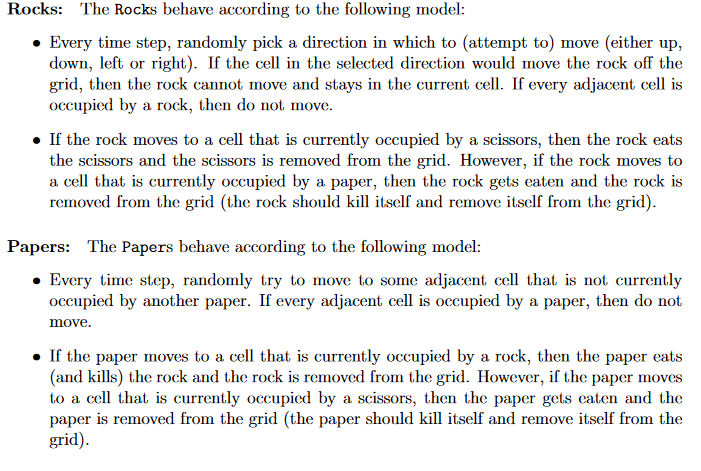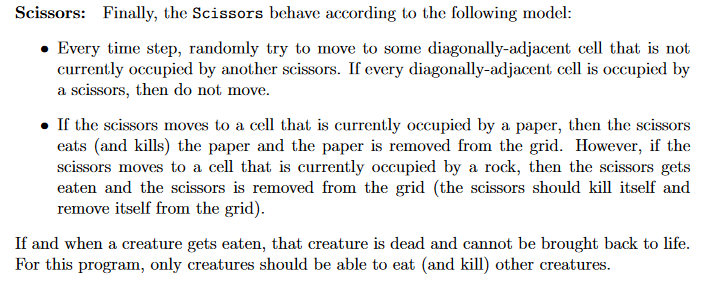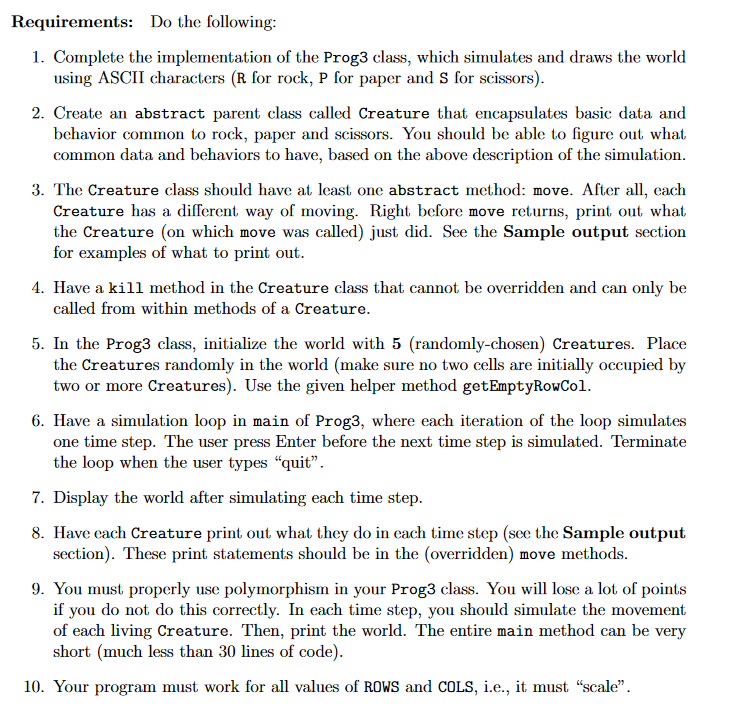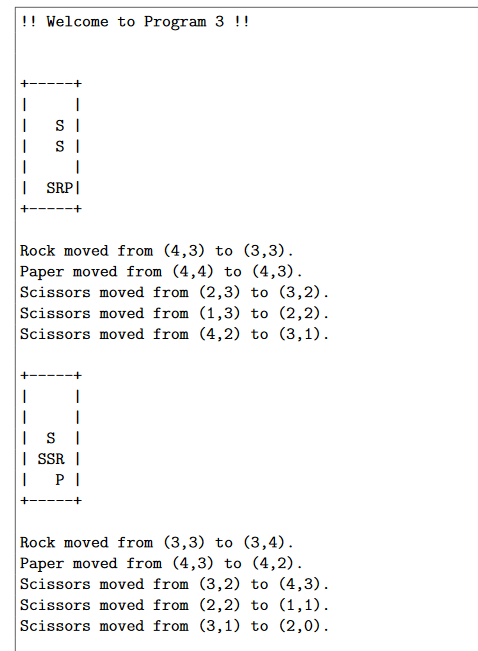Question
I will give an upvote if someone can give me any kind of help with this project. I need help with Initializing the creature world
I will give an upvote if someone can give me any kind of help with this project.
I need help with Initializing the creature world with 5 randomly chosen creature objects.(either rock, paper or scissors). then when the user presses enter the creatures should move in the direction specified below.





Starting code:
import java.util.*; public class Prog3 { public static final int ROWS = 5; public static final int COLS = 5; // you will probably need to have many more final values // do not have any non-final data here
public static void main(String args[]) { System.out.println("!! Welcome to Program 3 !!");
Creature[][] world; Creature[] creatures;
//intialize the Creature[][] world with null world = new Creature[ROWS][COLS]; for (int r = 0; r
// simulates the dynamical system. MAIN GAME LOOP while(true){ pressEnter = in.nextLine(); if(pressEnter.equals("exit")) break; } System.out.println("Done. Normal termination."); }
private static int[] getEmptyRowCol(Creature[][] inWorld) { // Assume inWorld has at least one row and one column Random Random rand = new Random(); int rrow = rand.nextInt(inWorld.length), rcol = rand.nextInt(inWorld[0].length); while (inWorld[rrow][rcol] != null) { rrow = rand.nextInt(inWorld.length); rcol = rand.nextInt(inWorld[0].length); } return new int[]{rrow, rcol}; }
private static void printWorld(Creature[][] inWorld) { System.out.print("+"); for (int i = 0; i
public abstract class Creature { /ot sure if these variables should be here public final static int NORTH = 0; public final static int SOUTH = 1; public final static int WEST = 2; public final static int EAST = 3; public final static int NUM_DIRECTIONS = 4; protected final String name; protected final int startRow, startCol; //I am not sure what all should be in this constructor public Creature(String inName, int inStartRow, int inStartCol){ name = inName; startRow = inStartRow; startCol = inStartCol; } public abstract void move(Creature[][] inWorld); //toString method //kill method }
import java.util.*;
public class Rock extends Creature {
public Rock(String name, int inStartRow, int inStartCol){ super(name, inStartRow, inStartCol); }
// there might be some errors but this is the general format of how move should be implemented. public void move(Creature[][] inWorld) { int row = startRow,col = startCol;
int prevRow = row, prevCol = col; int rint = new java.util.Random().nextInt(NUM_DIRECTIONS); if (rint == NORTH && row > 0 && !(inWorld[row - 1][col] instanceof Rock)) row--; else if (rint == SOUTH && row 0 && !(inWorld[row][col - 1] instanceof Rock)) col--; else if (rint == EAST && col
if (prevRow != row || prevCol != col) { System.out.println("Rock moved from " + "(" + prevRow + "," + prevCol + ") " + "to " + "(" + row + "," + col + ")."); if (inWorld[row][col] == null) { // ?? } else { Creature other = inWorld[row][col]; if (other instanceof Scissors) { // ?? System.out.println("Rock killed Scissors at " + "(" + row + "," + col + ")."); } else if (other instanceof Paper) { // ?? System.out.println("Rock killed by Paper at " + "(" + row + "," + col + ")."); } } inWorld[prevRow][prevCol] = null; } else System.out.println("Rock at " + "(" + row + "," + col + ") " + "could not move."); } // toString? }
public class Scissors extends Creature { public Scissors(String name, int inStartRow, int inStartCol) { super(name, inStartRow, inStartCol); }
public void move(Creature[][] inWorld) { } }
public class Paper extends Creature { public Paper(String name, int inStartRow, int inStartCol) { super(name, inStartRow, inStartCol); }
public void move(Creature[][] inWorld) { } }
final output:

Step by Step Solution
There are 3 Steps involved in it
Step: 1

Get Instant Access to Expert-Tailored Solutions
See step-by-step solutions with expert insights and AI powered tools for academic success
Step: 2

Step: 3

Ace Your Homework with AI
Get the answers you need in no time with our AI-driven, step-by-step assistance
Get Started


